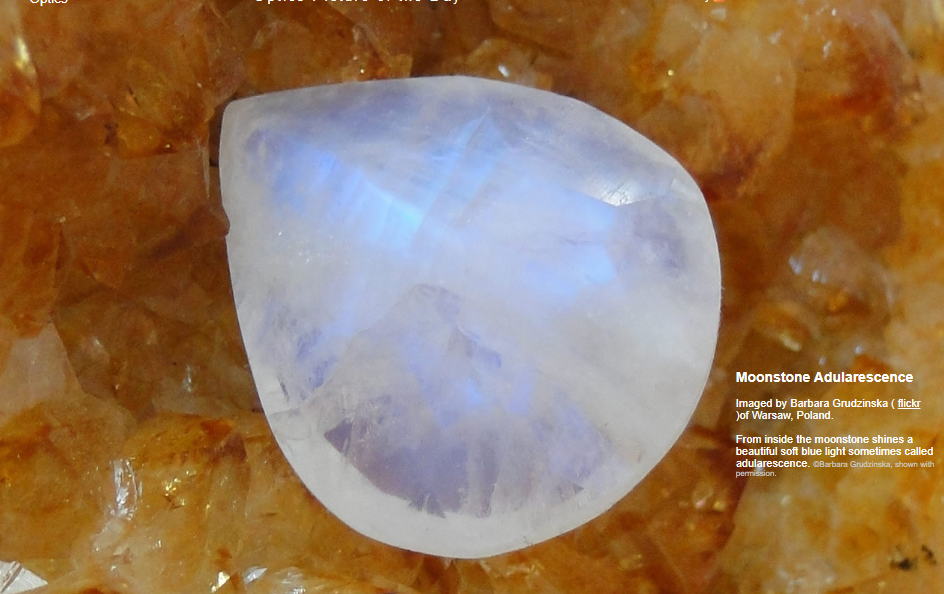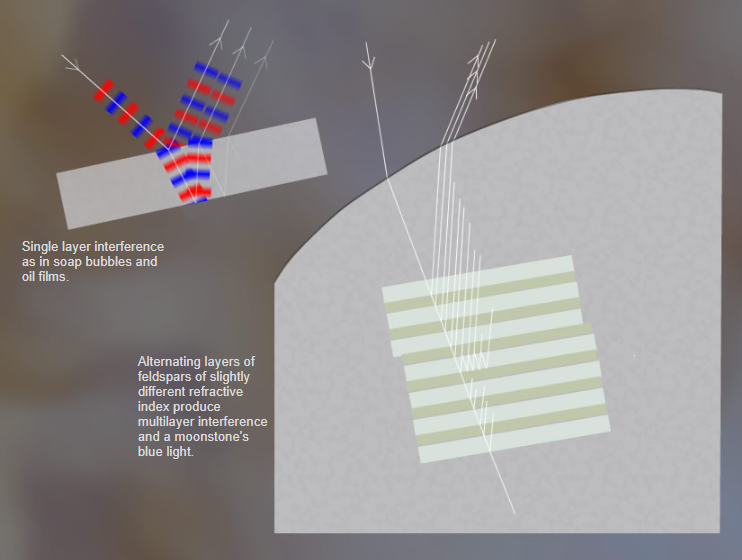OPOD - Moonstone adularescence
Moonstone Adularescence: A Mystical Display of Light
Moonstones, with their ethereal beauty, captivate the imagination with their soft blue glow known as adularescence. These gemstones, often colorless or milky white with hints of gray or peach, reveal their prized blue shimmer when viewed from certain angles. However, this captivating blue is not an inherent mineral color; instead, it arises from a mesmerizing optical phenomenon called iridescence, specifically multi-layer interference of light.
Moonstones belong to the feldspar family, a group of complex sodium potassium aluminum silicates. Within these gemstones, domains of alternating layers with slightly different compositions can be found. These layers consist of sodium-rich albite and potassium-rich orthoclase, which are the compositional extremes or end members of feldspars. When a feldspar melt cools, the albite solidifies first, leaving behind a neighboring potassium-rich liquid that gradually solidifies into orthoclase. This process creates a regular stack of alternating layers, each less than a micron thick, composed of sodium-rich and potassium-rich material.
The magic of moonstone adularescence lies in the optical properties of these alternating layers. As light passes through the layers, it undergoes reflection and refraction at their interfaces. The reflected light waves then interfere with each other, resulting in the mesmerizing display of colors. To better understand this interference mechanism, let's consider what happens at a single thin layer, such as a soap bubble or an oil film on water.
When light strikes the layer, part of it is reflected from the front surface, while another part enters the film and reflects off the rear surface before leaving in the same direction as the front reflected wave. These two outgoing waves combine, and depending on their phase condition (i.e., whether their wave crests coincide or are out of phase), we observe either light or darkness. This phase condition is wavelength-dependent, giving rise to the interference colors we see in moonstone.
However, the effect of interference is greatly enhanced when there are multiple layers with regular spacing and thickness. In such cases, the light leaving the structure undergoes several reflections between layers, each with its own interference possibilities. It is this intricate interplay of light that ultimately produces the captivating blue hue in moonstone. This phenomenon of multilayer interference also manifests in other minerals like labradorite, opal, tiger's eye, and even in the lustrous and pastel colors of seashells.
The enchanting allure of moonstone adularescence has fascinated humans for centuries. This gemstone's ability to transform and shimmer in different lighting conditions evokes a sense of mystery and magic. The play of light within its depths echoes the ever-changing nature of the moon itself, lending moonstone a connection to lunar energy and symbolism. It is no wonder that moonstone has been revered as a stone of intuition, balance, and feminine energy throughout history.
In addition to its captivating optical properties, moonstone holds cultural significance in various societies. For instance, in India, it is considered a sacred stone associated with love and fertility. In ancient Rome, moonstone was believed to be formed from solidified moonbeams. Even today, moonstone continues to be highly valued in the world of jewelry, often adorning rings, pendants, and earrings with its enchanting glow.
As we delve into the realm of atmospheric optics, moonstone adularescence stands as a testament to the wonders that nature has to offer. Its soft blue light reminds us of the beauty that can be found in the hidden depths of seemingly ordinary objects. So next time you catch a glimpse of a moonstone shimmering with its otherworldly glow, take a moment to appreciate the intricate dance of light and layers that brings forth this magical spectacle.

Moonstone Adularescence
Imaged by Barbara Grudzinska ( flickr )of Warsaw, Poland.
From inside the moonstone shines a beautiful soft blue light sometimes called adularescence. ©Barbara Grudzinska, shown with permission.

Moonstones are colourless, milky white or sometimes grey or peach coloured. The prized blue - adularescence or schiller - comes from deep within the stone when viewed at certain angles. The blue is not an intrinsic mineral colour. It is instead a form of iridescence arising from multi-layer interference of light.
Moonstone is a feldspar, within the stone there are domains of alternating layers of slightly different composition.
Feldspars are complex sodium potassium aluminium silicates. Albite (sodium rich) and orthoclase (potassium rich) are compositional extremes or end members of feldspars. As a feldspar melt cools, albite solidifies first leaving an adjacent potassium rich liquid which then forms an orthoclase tending solid. That leaves an adjacent albite rich liquid. The outcome can be a regular stack of alternating layers each less than a micron thick of sodium rich and potassium rich material.
The alternating layers have slightly different optical properties and light passing through them is reflected and refracted at their interfaces. The reflected light waves interfere to produce the adularescence colours.
The interference mechanism is more easily understood by looking at what happens at a single thin layer as is found in a soap bubble or an oil film on water. Light striking the layer is part reflected from the front surface. Another part enters the film, reflects off the rear surface and leaves in the same direction as the front reflected wave. The two outgoing waves combine. If their wave crests (shown at far left as red for positive and blue for negative) coincide then there is light in that direction. When they are out of phase there is destructive interference and there is darkness. The phase condition is wavelength dependent with the result that we see interference colours.
The effect is much enhanced when there are multiple layers of regular spacing and thickness. The light leaving the structure is then the outcome of several reflections between layers, each with interference possibilities. We see blue because of the particular layer thicknesses and spacing in moonstone.
Multilayer interference gives colours in other minerals, labradorite, opal, tiger’s eye and in the lustre and pastel colours of sea shells.
Note: this article has been automatically converted from the old site and may not appear as intended. You can find the original article here.
Reference Atmospheric Optics
If you use any of the definitions, information, or data presented on Atmospheric Optics, please copy the link or reference below to properly credit us as the reference source. Thank you!
-
<a href="https://atoptics.co.uk/blog/opod-moonstone-adularescence/">OPOD - Moonstone adularescence</a>
-
"OPOD - Moonstone adularescence". Atmospheric Optics. Accessed on April 16, 2024. https://atoptics.co.uk/blog/opod-moonstone-adularescence/.
-
"OPOD - Moonstone adularescence". Atmospheric Optics, https://atoptics.co.uk/blog/opod-moonstone-adularescence/. Accessed 16 April, 2024
-
OPOD - Moonstone adularescence. Atmospheric Optics. Retrieved from https://atoptics.co.uk/blog/opod-moonstone-adularescence/.